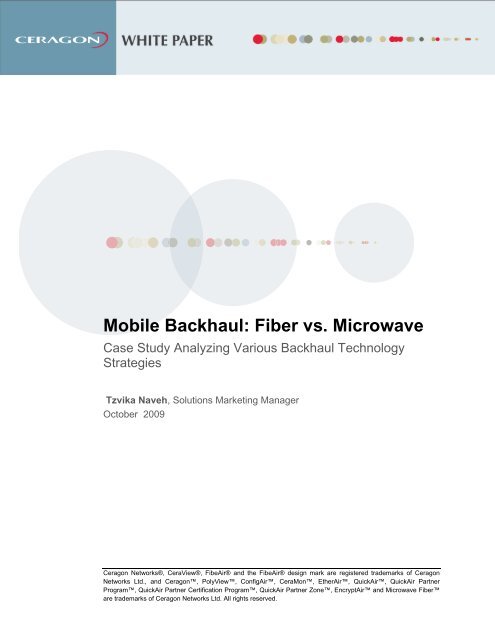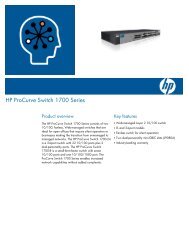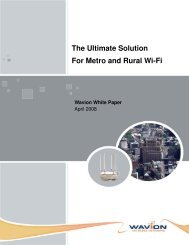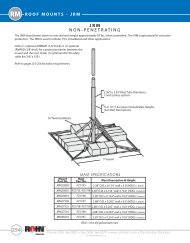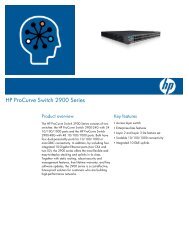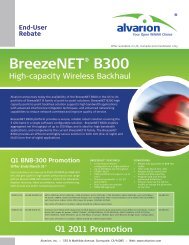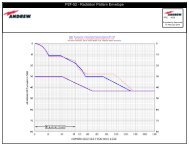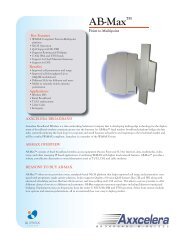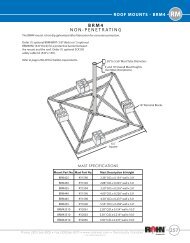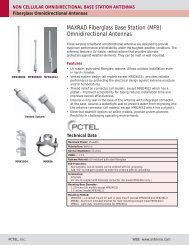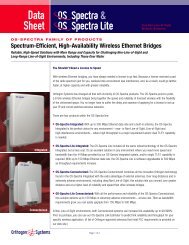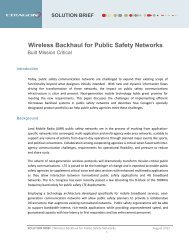Mobile Backhaul: Fiber vs. Microwave - DigitalAir Wireless Networks
Mobile Backhaul: Fiber vs. Microwave - DigitalAir Wireless Networks
Mobile Backhaul: Fiber vs. Microwave - DigitalAir Wireless Networks
You also want an ePaper? Increase the reach of your titles
YUMPU automatically turns print PDFs into web optimized ePapers that Google loves.
<strong>Mobile</strong> <strong>Backhaul</strong>: <strong>Fiber</strong> <strong>vs</strong>. <strong>Microwave</strong><br />
Case Study Analyzing Various <strong>Backhaul</strong> Technology<br />
Strategies<br />
Tzvika Naveh, Solutions Marketing Manager<br />
October 2009<br />
Ceragon <strong>Networks</strong>®, CeraView®, FibeAir® and the FibeAir® design mark are registered trademarks of Ceragon<br />
<strong>Networks</strong> Ltd., and Ceragon, PolyView, ConfigAir, CeraMon, EtherAir, QuickAir, QuickAir Partner<br />
Program, QuickAir Partner Certification Program, QuickAir Partner Zone, EncryptAir and <strong>Microwave</strong> <strong>Fiber</strong><br />
are trademarks of Ceragon <strong>Networks</strong> Ltd. All rights reserved.
Introduction<br />
The advent of 3G and 4G mobile services brings with it a surge in data traffic, which in turn<br />
puts a strain on existing cellular networks. Nowhere is the demand for more available capacity<br />
felt more than in the <strong>Backhaul</strong>.<br />
Looking into their backhaul options, operators can choose one of three physical mediums;<br />
copper, fiber or microwave. A recent report by Heavy Reading Research 1 estimates that<br />
microwave represents nearly 50% of global backhaul deployments. As shown in Figure 1, the<br />
report also finds that the use of microwave is not distributed evenly across nations. In fact,<br />
microwave is frequently deployed in developing markets and in emerging markets in which<br />
fiber is not available. <strong>Microwave</strong> is also frequently used in developed markets as an<br />
alternative to costly line-leasing services offered by Telecom incumbents.<br />
Copper networks, that according to Heavy Reading make up for nearly 20% of all backhaul<br />
deployments, are likely to decrease due to their limited capacity support and their inability to<br />
scale in a cost efficient manner. Looking forward, fiber is expected to take the place of copper<br />
based wire-line connections, and increase its overall share (albeit not at the expense of<br />
<strong>Microwave</strong>).<br />
Figure-1: Estimate for the global share of cell-site connectivity of microwave fiber and copper at the end of 2008<br />
and Global layer 1 backhaul technology forecast (Source : Heavy Reading)<br />
This paper compares two self-owned backhaul alternatives: fiber and point-to-point<br />
microwave. In the following chapters we will attempt to shed some light on the considerations<br />
that impact the decision making process of operators when choosing the right backhaul option<br />
for their network. We will also cover regional aspects and present a case study based on real<br />
life parameters.<br />
1 Ethernet <strong>Backhaul</strong> Quarterly Market Tracker, Heavy Reading Research, July 2009<br />
WHITE PAPER | <strong>Fiber</strong> <strong>vs</strong>. <strong>Microwave</strong><br />
2
Comparing <strong>Microwave</strong> with Alternate Technologies<br />
This discussion focuses on fiber <strong>vs</strong>. microwave assuming a cost and capacity evolution as<br />
described in Figure 2 below.<br />
Figure-2: <strong>Mobile</strong> backhaul technology evolution. Ethernet microwave appears as a reasonable solution as<br />
capacity increase and backhaul cost decrease.<br />
For the sake of discussion let us consider the relevance of two additional alternatives<br />
infrastructure; Copper and Cable. Copper based services are designed for E1 or DS1<br />
services. Supporting 1.5-2Mpbs, Copper lines do not scale easily to provide adequate<br />
bandwidth at a distance above few hundred meters to support broadband usage of 3G and<br />
emerging LTE/4G technologies. For longer distances, bonding configurations are required in<br />
which monthly costs increase linearly with bandwidth requirements. xDSL technology was<br />
thought to be a good method for offloading data traffic, but this too was abandoned in favour<br />
of fiber.<br />
Another promising contender is backhaul based on Multiple System Operator (MSO)<br />
infrastructure leveraging DOCSIS 3.0 high capacity to backhaul wireless base stations. Two<br />
reasons make it less relevant for this discussion; First, it is a shared media technology,<br />
making it difficult to deploy with the right traffic engineering. Secondly, MSO and Hybrid-<strong>Fiber</strong>-<br />
Coax (HFC) foot print is limited to only a few countries such as the US, UK and Germany. In<br />
rest of the world, Cable footprint is considered insignificant. On the other hand, in places<br />
where MSOs play and own substantial fiber assets, they can leverage those assets to offer<br />
high capacity, fiber based Ethernet services for cell sites situated near their POPs.<br />
Operators have traditionally used the following basic strategic guidelines to decide which<br />
technology to use in their backhaul:<br />
WHITE PAPER | <strong>Fiber</strong> <strong>vs</strong>. <strong>Microwave</strong><br />
3
1. Incumbent operators: Self deploy and rely as much as possible on existing facilities,<br />
while laying new fiber when and where an up-selling is possible. This assumes large<br />
capital resources and long-term ROI models<br />
2. Challenger/competitive operators: Challengers typically have more limited<br />
resources and a limited installed base, leading to two major backhaul strategies; One<br />
is to self-deploy backhaul relying almost entirely on microwave (examples include<br />
Orange Spain and Orange UK both with over 95% microwave in their network). On<br />
the other hand, some operators opt for leasing copper or fiber from incumbents or<br />
other challengers (such as T-<strong>Mobile</strong> US that has only 5% self built microwave and<br />
relies almost entirely on leased line services).<br />
The reasons for choosing one way or the other are related to ownership structure,<br />
available cash during inception and long term strategic plans.<br />
3. Rural Broadband operators: Mainly self deployed microwave. Leased fiber may be<br />
used for some of the core when the price is right.<br />
Table 1 summarizes briefly the main difference between microwave and fiber<br />
<strong>Microwave</strong><br />
<strong>Fiber</strong> lines<br />
Capacity Up to several Gbps Unlimited<br />
Regulation<br />
<br />
<br />
Requires spectrum<br />
Visual impact considerations<br />
<br />
Requires right of ways and<br />
infrastructures; renovation construction<br />
works after trenching<br />
Distance influence on<br />
Costs and Deployment<br />
Time<br />
<br />
<br />
Cost per link with some<br />
incremental cost with the<br />
distance<br />
Fast deployment time<br />
<br />
<br />
Costs increase per feet/meter<br />
Deployment time increases linearly with<br />
distance<br />
Terrain<br />
<br />
<br />
Suitable for any terrain<br />
Requires line-of-sight<br />
between two link end-points<br />
<br />
<br />
Becomes costly when trenching in<br />
difficult terrain (Mountains, Desert,<br />
swamps, rocky plains or Jungles)<br />
Accessibility - requires access for<br />
vehicles along the trenching path<br />
Reuse options<br />
<br />
Equipment can be<br />
disassembled and relocated<br />
somewhere else<br />
<br />
<br />
<strong>Fiber</strong>, in most cases, cannot be<br />
relocated<br />
Copper ducts may be reused for fiber<br />
lines<br />
Climate<br />
<br />
<br />
Influenced by climate<br />
Adaptive modulation and a<br />
proper link planning reduces<br />
climate effects<br />
<br />
Table-1: <strong>Microwave</strong> and <strong>Fiber</strong> consideration<br />
Normally, not influenced , except for<br />
floods<br />
WHITE PAPER | <strong>Fiber</strong> <strong>vs</strong>. <strong>Microwave</strong><br />
4
Regional Differences in <strong>Microwave</strong> <strong>Backhaul</strong> Adoption<br />
Globally, an increasing percentage of new backhaul investment is in microwave. But to<br />
estimate demand, one needs to understand how acceptance differs on a regional basis as<br />
well as by each individual carrier. Several such examples are depicted in table 2 below:<br />
Country Carrier Legacy Installed Base Strategic Direction<br />
Italy<br />
Vodafone<br />
Mainly microwave, following a 1995<br />
decision to avoid reliance on Telecom<br />
Italia’s leased lines<br />
Subject to periodic review<br />
U.K. Vodafone High reliance on leased lines Aggressive shift to microwave<br />
U.K. “3”<br />
Relies mainly on leased lines. Decision<br />
made in order to avoid initial CapEx hit<br />
from self-building microwave on top of an<br />
$8B 3G license fee and aggressive<br />
network rollout expenditure<br />
Subject to periodic review, probable<br />
shift to microwave in the future<br />
U.K.<br />
Orange<br />
High proportion of microwave, but early<br />
generation of point-to-point microwave<br />
now nearing end of life<br />
Considering upgrade options including<br />
new microwave and fiber<br />
U.S.<br />
Sprint<br />
High reliance on microwave, using multiple<br />
platforms<br />
Shift in balance toward microwave<br />
France SFR High reliance on leased lines Aggressive shift to microwave<br />
Malaysia<br />
Maxis<br />
High proportion of point-to-point<br />
microwave<br />
Trialing Point-to-multipoint<br />
Table-2: Regional Differences in <strong>Microwave</strong> <strong>Backhaul</strong> Adoption. Based on Heavy Reading Research, <strong>Backhaul</strong><br />
Strategies for <strong>Mobile</strong> Carriers,<br />
Regional differences depend on a number of factors including the availability of equipment,<br />
spectrum and licence costs, the extent of existing copper and fiber resources and<br />
geographical span. <strong>Microwave</strong> spectrum is more expensive, for example, in Europe than in<br />
Africa, where the regulatory conditions are relaxed and bandwidth is plentiful. The mobile<br />
affiliates of fixed operators are more likely to use the leased lines and fiber of their affiliate,<br />
while “challenger” operators will more frequently rely on microwave. While fiber essentially<br />
provides unlimited bandwidth with the aid of wave division multiplexing (WDM), it is expensive<br />
and challenging to deploy. The business case for microwave rests on its ease of deployment<br />
and greater range, performance and flexibility. CAPEX is offset by low OPEX, making<br />
microwave more cost effective.<br />
WHITE PAPER | <strong>Fiber</strong> <strong>vs</strong>. <strong>Microwave</strong><br />
5
Case Study<br />
This case study describes two self-owned mobile backhaul scenarios, as shown in Figure 3. It<br />
assumes new cell sites (not co-located) that need to be backhauled to the RNC/MME site. We<br />
will assume the bandwidth required in the range of 25Mbps – 500Mbps and that the changing<br />
variable is the distance from the cell-site to the aggregation site.<br />
Figure-3: <strong>Mobile</strong> <strong>Backhaul</strong> Case study domain<br />
In our example we assume that Switch/ADM equipment for aggregation is installed at Hub<br />
site. At the cell site we either have switch / MSPP connected to fiber all the way to the<br />
aggregation equipment or a licensed wireless microwave link that holds integrated Carrier<br />
Ethernet switching capabilities (e.g. Ceragon FibeAir IP-10). On the far end of the link, in the<br />
aggregation site, we assume we already have a mast in place over the rooftop for backhaul<br />
antenna.<br />
Let us now consider the set up costs for each of the two backhaul alternatives using cost<br />
estimates that were recently published by a number of market research firms. As shown in<br />
Table 4 fiber trenching costs are highly influenced by population density (i.e. rural,<br />
metropolitan and urban), terrain and regulation. In the table below trenching costs already<br />
include the needed infrastructure renovation construction works and right-of-way.<br />
WHITE PAPER | <strong>Fiber</strong> <strong>vs</strong>. <strong>Microwave</strong><br />
6
<strong>Fiber</strong> Optic Lines<br />
Ethernet Switch or TDM multiplexer $2,500<br />
Trenching Costs [$ per meter]<br />
Including infrastructures renovation<br />
construction works and right-of-way<br />
Rural $30<br />
Metropolitan $90<br />
Urban $130<br />
<strong>Fiber</strong> Costs [$ per meter]<br />
Including fiber, connectors, fusions and tests<br />
$<br />
7<br />
Table-4: Trenching fiber optic costs. Source –Wireline operator<br />
The costs of setting up a microwave backhaul link, according to industry average, are shown in Table 5.<br />
<strong>Wireless</strong> <strong>Microwave</strong> Link (two terminals)<br />
Costs - Including equipment cost,<br />
installation cost, antenna, and annual<br />
maintenance costs including licensefees<br />
1+0 <strong>Microwave</strong> link $16,000<br />
1+1 <strong>Microwave</strong> link $30,000<br />
Trunk (Long haul)<br />
<strong>Microwave</strong> link<br />
$40,000<br />
Erect new tower at the cellular base station for wireless backhaul $50,000<br />
Total 1+0 <strong>Microwave</strong> link (including new tower setup) $66,000<br />
Total 1+1 <strong>Microwave</strong> link (including new tower setup) $80,000<br />
Total Trunk (Long haul) <strong>Microwave</strong> link (including new tower setup) $90,000<br />
Table-5: <strong>Wireless</strong> point-to-point microwave link costs<br />
In order to compare fiber and microwave not only according to cost and capacity parameters,<br />
but also in terms of reliability and distance, our case study shows a 1+1 protected wireless<br />
link configuration as well as a wireless long- haul Trunk solution alongside the typical 1+0<br />
unprotected wireless link.<br />
Comparing the various mobile backhaul scenarios versus the increasing distance from the<br />
cell-site to the aggregation site, will result the following diagram:<br />
WHITE PAPER | <strong>Fiber</strong> <strong>vs</strong>. <strong>Microwave</strong><br />
7
Figure-4: <strong>Microwave</strong> and <strong>Fiber</strong> backhaul solutions <strong>vs</strong>. Distance<br />
Figure 4 clearly shows that in Greenfield base-station deployment scenarios - in which new<br />
towers need to be erected for point-to-point microwave - fiber optics are more cost effective<br />
over short distances (up to 500m/0.3 miles). Yet, in urban environments, tower set-up is not<br />
always required (antennas can be mounted on rooftops for example). In this case the<br />
microwave option becomes much more attractive even at a very short distance.<br />
In rural environments microwave becomes more cost effective at around 1.6 Km (~1mile)<br />
when tower set-up costs are involved – though even here, new towers are not always required<br />
(in which case microwave is more attractive almost from the get-go). At distances above<br />
2.5Km (~1.7 miles) self-owned fiber becomes so expensive, that even a protected Trunk<br />
solution becomes more cost effective.<br />
Table 3 below sums up a number of assumptions used form the case study discussed in this<br />
section. It is important to mention these assumptions as they might tip the scale in favour of<br />
one technology or another.<br />
WHITE PAPER | <strong>Fiber</strong> <strong>vs</strong>. <strong>Microwave</strong><br />
8
Assumption<br />
No up-selling<br />
opportunities<br />
Need to erect<br />
a new tower<br />
for wireless<br />
backhaul<br />
Repeaters<br />
Time to deliver<br />
Accounting<br />
rules<br />
Explanation<br />
Operators might leverage existing facilities to generate<br />
more revenues<br />
Tower cost is roughly $50,000 to construct, and in this<br />
case all cost is associated with the backhaul budget<br />
and not part of the RAN budget. Obviously a more<br />
realistic approach would share these costs as towers or<br />
roof top poles are required for the base station and<br />
therefore should not impact the microwave case.<br />
At long distances, <strong>Microwave</strong> links would require<br />
expensive repeaters while fiber repeaters are less<br />
costly and anyhow are required only after very long<br />
distances. This is not part of the discussion as these<br />
state level investments have more complex business<br />
models<br />
Time to deliver is not monetized as <strong>Microwave</strong> is an<br />
almost instant media while fiber projects may take<br />
years to approve and deploy<br />
makes for some operators long term investments in<br />
fiber, deprecated over 20 years a smart investment<br />
while radios are deprecated in shorter cycles (5-8<br />
years) making it a better investment for others<br />
Table-3: <strong>Microwave</strong> and <strong>Fiber</strong> simplicity assumptions<br />
Impact on<br />
<strong>Microwave</strong><br />
Negative<br />
Positive<br />
Negative<br />
Positive<br />
Negative /<br />
Positive<br />
Summary<br />
Though fiber-based networks can easily support the rapid growth in bandwidth demands, they<br />
carry high initial deployment costs and take longer to deploy than microwave. In most cases<br />
the Return-On-Investment (ROI) in fiber installations can only be expected in the long term,<br />
making it hard for operators to achieve lower costs per bit and earn profits in the foreseeable<br />
future.<br />
<strong>Wireless</strong> microwave backhaul solutions on the other hand are capable of delivering high<br />
bandwidth, carrier-grade Ethernet and TDM services. <strong>Microwave</strong> is suitable for all capacities<br />
up to several Gbps over a single link and may be scaled up to multiple Gbps using<br />
aggregated links techniques. Unlike fiber, wireless solutions can be set up quickly and are<br />
much more cost efficient on a per-bit basis from day one.<br />
From the market data shown in this article and the case study it presented, it is clear that<br />
leased copper lines are becoming too costly - and too inefficient - for the increasing capacities<br />
WHITE PAPER | <strong>Fiber</strong> <strong>vs</strong>. <strong>Microwave</strong><br />
9
equired for 4G/LTE backhaul. It was also shown that fiber optic sweet spot relies both in short<br />
backhaul distances and at aggregation sites where ultra high bandwidths are required.<br />
<strong>Wireless</strong> microwave solutions on the other hand, offer a versatile backhaul option for both<br />
short and long-haul deployments. At distances over several hundred meters, <strong>Microwave</strong> offers<br />
a much better cost-per-bit ratio than fiber, without compromising on availability or reliability.<br />
The main reason for mobile operators to use microwave for backhaul is total cost of<br />
ownership. With few exceptions, microwave emerged as the de-facto solution for access and<br />
aggregation backhaul of mobile traffic, both for voice and data services.<br />
WHITE PAPER | <strong>Fiber</strong> <strong>vs</strong>. <strong>Microwave</strong><br />
10
Glossary<br />
ADM<br />
DOCSIS<br />
DWDM<br />
HFC<br />
LTE<br />
MME<br />
MSO<br />
MSPP<br />
RNC<br />
Add/Drop Multiplexer<br />
Data Over Cable Service Interface Specification<br />
Dense wavelength division multiplexing<br />
Hybrid <strong>Fiber</strong> Coax<br />
Long term Evolution<br />
Mobility Management Entity<br />
Multiple System Operator<br />
Multi-Service Provisioning Platform<br />
Radio Network Controller<br />
ABOUT CERAGON<br />
Ceragon <strong>Networks</strong> Ltd. (NASDAQ: CRNT) is the premier wireless backhaul<br />
specialist.<br />
Ceragon’s high capacity wireless backhaul solutions enable cellular operators and<br />
other wireless service providers to deliver 2G/3G and LTE/4G voice and data<br />
services that enable smart-phone applications such as Internet browsing, music<br />
and video.<br />
With unmatched technology and cost innovation, Ceragon’s advanced point-topoint<br />
microwave systems allow wireless service providers to evolve their<br />
networks from circuit-switched and hybrid concepts to all IP networks.<br />
Ceragon solutions are designed to support all wireless access technologies,<br />
delivering more capacity over longer distances under any given deployment<br />
scenario.<br />
Ceragon’s solutions are deployed by more than 230 service providers of all sizes,<br />
and hundreds of private networks in more than 130 countries.<br />
Visit Ceragon at www.ceragon.com<br />
WHITE PAPER | <strong>Fiber</strong> <strong>vs</strong>. <strong>Microwave</strong><br />
11


